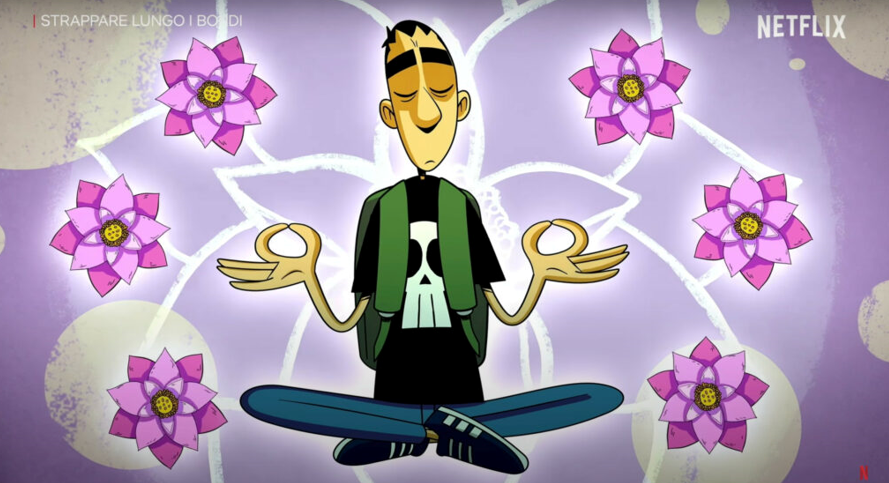Strappare lungo i bordi, the Italian cartoon making waves around the world
Contains plot spoilers
Content warning: This article contains discussion of suicide
Italian cartoonist Zerocalcare (meaning literally ‘zero limescale’) has, until now, been best known for his graphic novels, such as La profezia dell’armadillo (The Prophecy of the Armadillo). However, his Netflix animated series Strappare lungo i bordi (Tear Along the Dotted Line) has brought his work to a global audience for the first time after its release on 17th November 2021. Consisting of only six episodes, each around a quarter of an hour long, this show is surprising, hilarious and heartfelt from beginning to end.
The plot of the show is autobiographical; it follows the protagonist, Zero, as he relives experiences in his life through flashbacks and exaggerated storytelling. At the end of each episode, the plotline returns to the present day, for which the reason becomes clear in the final episodes. During the show, Zero is followed by his armadillo alter-ego, who guides him (and occasionally insults him) as he tries to figure out what the best thing to do in each situation is.
The cartoon is peppered with anecdotes about Zero’s life, friends and family. He introduces the viewer to his friends Alice and Sarah, both of whom dream of becoming teachers, and Secco, whose deadpan annamo a pijà un gelato? (‘shall we go and get an ice cream?’) pops up at the most inappropriate of moments.
At the beginning, the show is often light-hearted, and there are scenes that made me laugh out loud. The animated format allows for this particularly well; Zerocalcare’s exaggerated style allows him to recount stories of seemingly banal moments in a relatable and hilarious way. These are often moments inspired by experiences that the audience can identify with; he compares a freezing cold train to the Arctic tundra, for example, and tells the humiliating story of him trying to impress a girl by changing a tyre on his car, but ultimately fails to lift the vehicle and is forced to call his mum for help. Zerocalcare takes small, seemingly insignificant moments and turns them into detailed and humorous flashbacks, and this is part of what gives the show its charm.
However, the cartoon is not only a glimpse into the follies and foibles of the life of its awkward protagonist. On the contrary, it transforms into something more. As I mentioned, at the end of each episode the story moves back into the present, following Zero and his friends Sarah and Secco as they travel somewhere by train. When they are greeted at the station by two older people, their identities are initially unclear, but later we find out they are the parents of their friend Alice, who we find out has died by suicide.
After this revelation, the show changes tone in its final episode, most notably with the introduction of different voices. In Episodes 1-5, Zerocalcare had voiced all the characters, with Alice’s voice having a filtered and robotic quality. In Episode 6, however, the characters are voiced by different actors, immediately giving a more human quality to the funeral scene, as each character finally has a voice that fits their artistic depiction. This paves the way for the most emotional moment of the show, when an audio clip of Alice telling a story to her children is played aloud to the crowd gathered at her funeral. The contrast between Alice’s earlier robotic voice and the tender, warm voice given to her here by Veronica Puccio provides for a heart-wrenching and emotional moment. The show ends with a message about suicide, encouraging the viewer to look out for those close to them.
This unexpected, important ending of the cartoon which seemed originally to be the light-hearted tale of an awkward main character is part of what gives this show its genius. The strong Roman dialect, coupled with the incredibly fast pace of speaking, can make the plot difficult to follow at times – but it is more than worth the extra concentration required. This is one of those rare series which provides moments of hilarity and heart-wrenching emotion within the same episode, often within minutes of each other. The art style is expressive, capable of conveying this humour and depth of emotion. This is certainly a series that I will be returning to.
Strappare lungo i bordi is now available to stream on Netflix.
Image credits: Zerocalcare/Netflix


